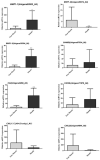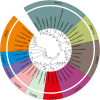Comparative Transcriptomic and Expression Profiles Between the Foot Muscle and Mantle Tissues in the Giant Triton Snail Charonia tritonis
- PMID: 33732164
- PMCID: PMC7959727
- DOI: 10.3389/fphys.2021.632518
Comparative Transcriptomic and Expression Profiles Between the Foot Muscle and Mantle Tissues in the Giant Triton Snail Charonia tritonis
Abstract
The giant triton snail (Charonia tritonis), an endangered gastropod species of ecological and economic importance, is widely distributed in coral reef ecosystems of the Indo-West Pacific region and the tropical waters of the South China Sea. Limited research on molecular mechanisms can be conducted because the complete genomic information on this species is unavailable. Hence, we performed transcriptome sequencing of the C. tritonis foot muscle and mantle using the Illumina HiSeq sequencing platform. In 109,722 unigenes, we detected 7,994 (3,196 up-regulated and 4,798 down-regulated) differentially expressed genes (DEGs) from the C. tritonis foot muscle and mantle transcriptomes. These DEGs will provide valuable resources to improve the understanding of molecular mechanisms involved in biomineralization of C. tritonis. In the Gene Ontology (GO) database, DEGs were clustered into three main categories (biological processes, molecular functions, and cellular components) and were involved in 50 functional subcategories. The top 20 GO terms in the molecular function category included sulfotransferase activity, transferring sulfur-containing groups, and calcium ion binding, which are terms considered to be related to biomineralization. In KEGG classifications, transcriptomic DEGs were mainly enriched in glycosaminoglycan biosynthesis-chondroitin sulfate/dermatan sulfate, and sulfur metabolism pathway, which may be related to biomineralization. The results of qPCR showed that three of the eight genes examined were significantly up-regulated in the mantle. The phylogenetic tree of BMP1 suggested a significant divergence between homologous genes in C. tritonis. Our results improve the understanding of biomineralization in C. tritonis and provide fundamental transcriptome information to study other molecular mechanisms such as reproduction.
Keywords: Charonia tritonis; biomineralization; foot muscle; mantle tissue; transcriptome.
Copyright © 2021 Zhang, Xu, Zhang, Jia, Zhang, He and Liu.
Conflict of interest statement
The authors declare that the research was conducted in the absence of any commercial or financial relationships that could be construed as a potential conflict of interest.
Figures






Similar articles
-
Giant Triton Snail Charonia tritonis Macrophage-Expressed Gene 1 Protein Ct-Mpeg1: Molecular Identification, Expression Analysis, and Antimicrobial Activity.Int J Mol Sci. 2022 Nov 2;23(21):13415. doi: 10.3390/ijms232113415. Int J Mol Sci. 2022. PMID: 36362196 Free PMC article.
-
Neuropeptides encoded within a neural transcriptome of the giant triton snail Charonia tritonis, a Crown-of-Thorns Starfish predator.Peptides. 2017 Dec;98:3-14. doi: 10.1016/j.peptides.2017.01.004. Epub 2017 Jan 10. Peptides. 2017. PMID: 28082215
-
Development and Interrogation of a Transcriptomic Resource for the Giant Triton Snail (Charonia tritonis).Mar Biotechnol (NY). 2021 Jun;23(3):501-515. doi: 10.1007/s10126-021-10042-7. Epub 2021 Jun 30. Mar Biotechnol (NY). 2021. PMID: 34191212 Free PMC article.
-
Complete mitochondrial genome of the giant triton snail Charonia tritonis (Tonnoidea: Charoniidae).Mitochondrial DNA B Resour. 2024 Jun 17;9(6):766-770. doi: 10.1080/23802359.2024.2363346. eCollection 2024. Mitochondrial DNA B Resour. 2024. PMID: 38895512 Free PMC article.
-
Molecular identification of a novel antimicrobial peptide in giant Triton snail Charonia tritonis: mRNA profiles for tissues and its potential antibacterial activity.Fish Shellfish Immunol. 2023 May;136:108734. doi: 10.1016/j.fsi.2023.108734. Epub 2023 Apr 5. Fish Shellfish Immunol. 2023. PMID: 37028689
Cited by
-
Molecular and Functional Characterization of a Short-Type Peptidoglycan Recognition Protein, Ct-PGRP-S1 in the Giant Triton Snail Charonia tritonis.Int J Mol Sci. 2022 Sep 21;23(19):11062. doi: 10.3390/ijms231911062. Int J Mol Sci. 2022. PMID: 36232364 Free PMC article.
-
Giant Triton Snail Charonia tritonis Macrophage-Expressed Gene 1 Protein Ct-Mpeg1: Molecular Identification, Expression Analysis, and Antimicrobial Activity.Int J Mol Sci. 2022 Nov 2;23(21):13415. doi: 10.3390/ijms232113415. Int J Mol Sci. 2022. PMID: 36362196 Free PMC article.
References
-
- Aungtonya A. N. C. (1994). The indo-pacific trumpet triton snail, Charonia tritonis L.: morphometrics of a species on the verge of local extinction. Phuket Mar. Biol. Cent. Spec. Publ. 13 137–140.
-
- Beu A. G. (1970). The Mollusca of the Genus Charonia (Family Cymatiidae). Trans. R. Soc. N.Z. 11 205–223.
-
- Bootsma N., Macey D. J., Webb J., Talbot V. (1988). Isolation and characterization of ferritin from the hepatopancreas of the mussel Mytilus edulis. Biol. Metals 1 106–111. 10.1007/bf01138068 - DOI
-
- Boraldi F., Lofaro F. D., Accorsi A., Ross E., Malagoli D. (2019). Toward the molecular deciphering of Pomacea canaliculata immunity: first proteomic analysis of circulating hemocytes. Proteomics 19:e1800314. - PubMed
LinkOut - more resources
Full Text Sources
Other Literature Sources
Research Materials
Miscellaneous

